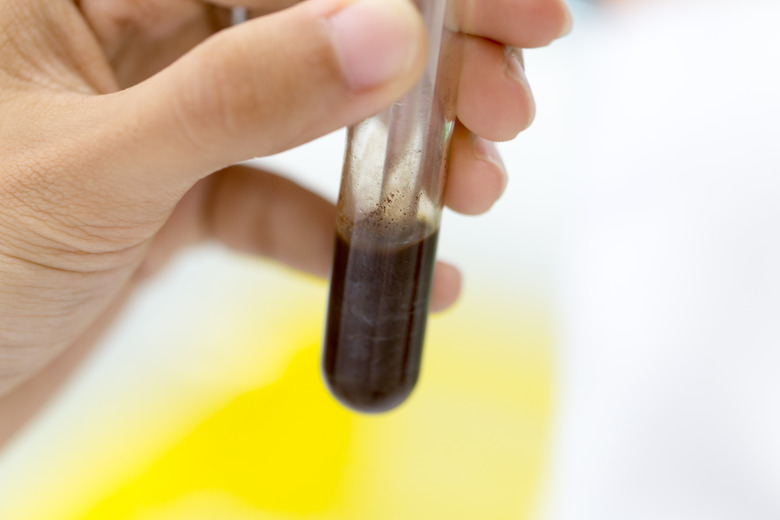Type Of Reactions With Copper & Nitric Acid
The reactions between copper and nitric acid are examples of oxidation-reduction reactions, where gaining electrons reduces one element and losing them oxidizes the other. Nitric acid is not only a strong acid, it is an oxidizing agent. Therefore, it can oxidize copper to Cu+2. If you plan to experiment with these reactions, it is important to remember that they release toxic, noxious fumes.
Solution Concentration
Solution Concentration
Copper can undergo one of two reactions when combined with nitric acid, depending on the concentration of the solution. If the nitric acid is dilute, the copper will be oxidized to form copper nitrate with nitric oxide as a byproduct. If the solution is concentrated, the copper will be oxidized to form copper nitrate with nitrogen dioxide as a byproduct. Both nitric oxide and nitrogen dioxide are noxious and potentially toxic at high levels; nitrogen dioxide is the ugly brown gas present in the smog haze over many cities.
Reaction Equations
Reaction Equations
The equations for the two reactions that can take place are:
Cu + 4 HNO3 –> Cu(NO3)2 + 2 NO2 + 2 H2O, which produces nitrogen dioxide and
3 Cu + 8 HNO3 –> 3 Cu(NO3)2 + 2 NO + 4 H2O, which produces nitric oxide.
With the concentrated acid, the solution will first turn green, then greenish-brown, and finally blue once diluted with water. Either reaction is highly exothermic and releases energy in the form of heat.
Oxidation and Reduction
Oxidation and Reduction
Another way to understand this reaction is by breaking it down into two half-reactions, one for oxidation (loss of electrons) and the other for reduction (gain of electrons). The half-reactions are: Cu –> Cu2+ + 2 e- , meaning that copper loses two electrons, and 2 e- + 4 HNO3 —> 2 NO3 1- + 2 H2O, which shows that two electrons have been transferred to the products. The speed of this reaction depends on the surface area of the copper; copper wire will react more quickly than copper bars, for example.
Other Considerations
Other Considerations
The solution changes color because of the water. Unlike the copper solid, the copper ions in solution can form a type of interaction called a coordination complex with the water molecules, and these complexes lend the solution a blue color. Mineral acids like hydrochloric acid do not oxidize copper in the same way as nitric acid because they are not strong oxidizing agents. Sulfuric acid, however, is a strong oxidizing agent. Under the right conditions, it will react with copper to release sulfur dioxide gas.
Cite This Article
MLA
Brennan, John. "Type Of Reactions With Copper & Nitric Acid" sciencing.com, https://www.sciencing.com/type-reactions-copper-nitric-acid-8517832/. 4 June 2018.
APA
Brennan, John. (2018, June 4). Type Of Reactions With Copper & Nitric Acid. sciencing.com. Retrieved from https://www.sciencing.com/type-reactions-copper-nitric-acid-8517832/
Chicago
Brennan, John. Type Of Reactions With Copper & Nitric Acid last modified March 24, 2022. https://www.sciencing.com/type-reactions-copper-nitric-acid-8517832/
